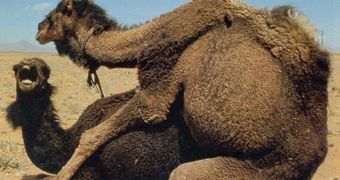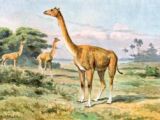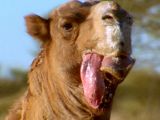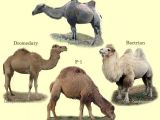1. The oldest known camel is Protylopus, appeared 40-50 million years ago (Eocene) in North America. It had the size of a rabbit and lived in forests. Later, camels spread to the savanna and increased their size. In Oligocene, 35 million years ago, Poebrotherium had the size of a roe deer, but already resembled a camel.
Between 24 and 12 million years ago, various types of camels evolved. Stenomylus was a gazelle like camel. Alticamelus, which lived 10 to 2 million years ago, had a long neck similar to a giraffe ones. Procamelus, just 1.2 m tall (like a modern llama) evolved in the Camelus genus (to which modern camels belong). Camelus passed from North America in Asia through Behringia 2-3 million years ago. 2 million years ago, the ancestors of lama and vicugna passed into the Andes coming from North America. The last camel surviving the cradle of the camel evolution, North America, was Camelops hesternus, which disappeared 12-10,000 years ago together with the whole megafauna of North America (mammoths, mastodons, giant sloth and saber toothed cats).
In 2005, scientists discovered in Syria a fossil dromadery species twice the size of the modern species.
2. There are 17 million camels worldwide. 90 % are dromedaries or Arabian camels (with one hump) and 75 % of the dromedaries are found in North/East Africa. 50 % of the world's dromaderies are found in Sudan and Somalia, in semidesert areas. 15-20,000 bewildered dromaderies roam western and central Australia.
Wild dromedaries are long extinct (the so-called wild dromedaries in some areas are just bewildered). Wild Bactrian camels still survive in the Gobi desert (between China and Mongolia), but they are endangered, the population being under 1,000. This wild Bactrian camels are not the race from which the domestic form comes. That type is believed to be extinct now in the wild.
There is the concept that camel is a strictly desert animal. Some say that camels are at the origin savanna animals, but wild camels were eliminated in the savanna by lions, against which they were defenseless, resisting in the desert due to the lack of big predators.
This is proved by the fact that dromedaries thrive better in less arid areas of their range: 3.6 individuals/square kilometer in Eastern Africa, 8.7 in Somalia, 1.7 in India, while their densities plummet to 0.4 in de deserts of west Africa, 0.14 in North Africa and Arabia and 0.08 in Sahara.
An interesting issue: the dromedary embryos have the bud for the second hump, but it remains undeveloped in this species.
3. Dromedary could have been domesticated in southwestern Arabia between 6,000 to 3,400 years ago, initially for their milk, while the larger and slower Bactrian camel (with two humps) in Northeastern Iran and southwestern Central Asia about 3,500 years ago. From Arabia, dromedaries entered Somalia, 3,500 years ago, and by 500 BC they reached the Atlantic coast.
4,000 years ago, Bactrian camels were spread with the Indo-Iranian invasion from Mesopotamia to the Indus valley and Afghanistan and reached 3,700-3,200 years ago western Siberia and Ukraine. 2,300 years ago they were present in China.
In the ninth century BC, dromedaries were involved in warfare, to carry archers and transport heavy loads. In 853 BC, the Assyrian king Shalmaneser III fought an army made of Syrians and Jews joined by the Arabian king Gindibu, with his army of 1,000 ...camel riders. The Assyrian chivalry was spooked by the sight of the unusual beasts and ran away. On the ruins of the city of Nineveh (the ancient Assyrian capital), on a relief can be seen the chivalry of king Assurbanipal (669-627 BC) fighting Arab camel riders.
The conquests of the Persian king Cyrus the Great (559-530) were based on the logistical support of dromedaries. In c.547, he fought against king Croesus of Lydia (modern western Turkey) and employed these animals in what was to become one of the most famous stratagems of Antiquity: "He gathered all the dromedaries from his army train, took off their burdens and set cavalry men upon them. Having thus furnished them, he ordered them to go in front of the rest of the army towards the horsemen of Croesus [...]. He did this because horses are afraid of dromedaries and can not endure to see or smell them." The Persian king Cambyses (530-522 BC) introduced for the first time dromedaries in Egypt. The Persian king Xerxes (485-465 BC) was proud of his camels and their Arabian riders.
Domesticated camels were used through much of North Africa, and the Romans had a corps of camel warriors to patrol the edge of the desert. Camels were also used by Romans for transportation, especially in the eastern provinces of Egypt, Arabia, Judaea, Syria, Cappadocia, and Mesopotamia. The Persian camels, however, were not particularly suited to trading or travel over the Sahara; rare journeys through the desert were still made on horse-drawn chariots.
Julius Caesar considered the greatest war catch after the defeat of the Numidian king Juba's camels. (Numidia is today northern Algeria). In 363 AD, general Romanus asked as a war tribute to the dwellers of the city Lepcis Magna (today Libya) 4,000 camels, for the transport of his army.
Much later, the Muslims claimed that Allah first created the camel, and after that the mountains, the deserts, the plains, the rivers, the seas and the other living things. Muhammad itself is said to have escaped from Mecca to Medina on the back of a camel. The Muslim supersition says that the left fore limb of the dromedary belongs to Satan.
The Islamic conquest of North Africa brought Arabian camels, fit to long desert journeys carrying a great deal of cargo. This boosted trade over the Sahara. Arabs also introduced the dromadery to Europe: 1020 in Spain, 1059 in Sicily, and by 1136 they reached the Rhine, but later disappeared from Europe. Still, a fossil species of camel, Camelus alutensis, related to modern species, inhabited Europe 2 million years ago.
The Bactrian Camels were the main burden beast on the Silk Road, linking China to Middle East.
Camel milk is the basic food of the Somali people, and many nomad tribes of the desert depend on the camels, like the Tuaregs of Sahara and Arab Bedouins, for transporting, milk, meat, wool (1.5 kg fro a dromadery, 4.5 kg fro a Bactrian camel) and leather. In Mongolia, the Bactrian Camels offer the hair from which the felt, the material for traditional yurt tents, is made.
Camel meat is taboo for the Non-Muslim populations of the Middle East and North Africa: Jews, Egyptian Copts (Christians), Zoroastrians (Iran), Mandaeans (Iraq, Iran), Neo-Assyrians (Syria, Iraq, Turkey), Ethiopians (Christians), while for Muslims in Egypt and other countries of Near East, basturma (salty camel meat) is considered a delicacy.
In many areas, camels were used for paying the bride's price.
4.Camels are gregarious and well adapted to their environment, the desert. They can carry heavy cargoes, stand sand storms and large temperature differences. Camels are called the "desert ships", and they can swim when they encounter water. The north Egyptian Lake Borollos has a depth varying between 20 cm and 2 m (0.6 to 6 ft). It cannot be crossed by boat or vehicles, and only camels can be used in this case.
A camel can resist 17 days without drinking under a scorching heat. It was wrongly believed its resistance resided in the water kept in the hump or in a stomach pouch. If it doesn't drinking anything for 17 days, a camel can lose a third of its weight, without being affected. But when it catches the opportunity, in can drink 104 liters of water at once (the Bactrian Camel, which is larger, can drink up to 120 liters), in 7-8 minutes! But three days later, there is no sign of water in its stomach or hump.
To resist the lack of water, the camels have several means of adjusting to the situation. Their body temperature varies depending on the environment: in the cooler morning is of 34o C, whereas during the hot afternoon it goes up to 40-41o C. The kidneys' function is regulated depending on the water availability: they produce 7 liters of urine when water is abundant, and 500 g when it does not drink for days. When thirsty, transpiration is reduced towards zero.
Camel's feces are dry (and used for fueling fire when drought) compared to another ruminants (just 40-60 % water): a dromadery loses 2.5 kg liters of water daily though feces while a cattle 20-40 liters! Camel feces are consumed by insects and gerbils (desert rats) (which recover this way a part of the water).
A camel's thick coat maintains an insulating layer, and it also reflects sunlight. A shorn camel has to sweat 50% more to avoid overheating. It also insulates them from the intense heat that radiates from hot desert sand. Their long legs help by keeping them further from the hot ground.
This ability to fluctuate body temperature and the efficiency of their sweating allows them to preserve about five liters of water a day.
The rest of the camel's body is adapted to the conditions in the desert: the hoof is perfect for the soft, instable sand, and the digits are wrapped in an elastic tissue that isolates the foot from the hot ground (while impeding deepening in the sand); the thick eyebrows and eyelashes protect the eyes against sand and sun; the nostrils are moved by muscles that can close them hermetically at will and the ears are filled of hairs that impede the sand to get in. This helps them retain expiration water and protects the animal during the sand storms. Horny layers on the chest, elbows and knees protect the camels against the scorching heat and insect.
Camels avoid stony deserts, as the gravel harms their feet.
Another issue: camels never run, they just speed up, in their typical gait of moving simultaneously the feet of the same part of the body. Running would raise transpiration. They can make daily 160 km (100 miles) with a speed of 16 km (10 mi)/hour. In caravans, they make 30-40 km (18-25 mi) per day, with an average age of 3.5 km (2.2 mi) per hour. The maximum speed achieved by a camel is 25 km (16 mi) per hour, but they get tired quickly.
Dromadery inhabits just warm deserts, as it cannot stand temperatures under 0o C, while the Bactrian camel resist to -25o C during the winter.
5.The camels' humps are reservoirs of fatty tissue. A full hump has 10-15 kg (22-33 pounds). When this fat is metabolized, it is not only a source of energy, but yields through reaction with oxygen from the air 1,111 g of water per 1,000 g of fat converted.
After drinking, water is spread uniformly in the body and it is lost gradually, about 100 liters in 17 days. The average water content of the camel's body is low: while the cow's tissues contain 80 % water, the donkey's (another desert animal) 65 %, and the camel's just 50 %. A camel crossing a desert loses in 24 hours only 2 % of its bodyweight, while the donkey at least 8 %. Curiously, wild Bactrian Camels from the Gobi desert (China-Mongolia) can drink saltwater.
Camels can withstand at least 20-25% weight loss due to sweating (most mammals can only withstand about 3-4% dehydration before cardiac failure due to the thickened blood).
But how can camels drink over 100 liters of water at once without serious consequences? This is the same as a human drinking 20 liters of water in 10 minutes. This would induce water intoxication in us. The red blood cells of the camels (and lamas, too) have an ovoid shape and the property of swelling round, till achieving a double volume and after that gradually release the stored liquid. The red blood cells are extremely small and numerous (132.5 million per cubic millimeter).
In their native lands, camels feel by far the presence of a fountain or river. They never forget the place where they have found water.
7. Camels walk 3 km (1.8 mi) per day looking for food, on average 3 hours, and disperse when food is scarce. They require 10-20 kg (22-44 pounds) of fresh food daily (or 5-10 kg (12-24 pounds) of dry food), depending on the animal's size. If working, the food requirement is of 30-50 kg (70-110 pounds) per day. They spend 8-12 hours per day eating.
Camels eat from small grasses and herbs (Convulvulaceae, Plantaginaceae) to bushes, trees (Acacia) (camels can pick up leaves at heights of up to 3.5 m (12 ft)), and plants growing on salty lands (Chenopodiaceae) and, as a camel's mouth is extremely tough and pain resistant, they can eat easily thorny desert plants, avoided by other animals. Some of their spines so hard they can penetrate through a shoe's sole. Camels literally can survive on plant wastes, like an old twig basket or a mat. Bactrian camels eat wild garlic, saxaul (Haloxylon), and poplar.
Camels can chew gazelle bones (for completing minerals), and even fish waists (especially in Southern Arabia, where fish is abundant). If food has enough moisture, camels can withstand a month without drinking water.
A density of 2-3 kg (4.5-6.5 pounds) of food per hectar means good feeding condition for the camel; 1-1.5 kg (2.2-3.5 pounds) per hectar represent poor feeding conditions.
8. Camels mate all year round, but they have a favorable period when vegetation is lush. The male is extremely aggressive during mating period (he can bite by the foot his rider). During the arousal, he shows off his teeth, salivate abundantly, and the epidermic glands of the neck and shoulders are extremely active. He urinates frequently, and keeps the head and the fore limbs as raised as possible. Males possess an organ called dulla, like a pink bladder, normally harbored in the throat. During the rut period, the male throws the dulla out of his mouth in a display dominance. Dulla hangs like an inflated pink tongue and at the same time the male burbles, a disgusting sight to most humans.
Male combats for females can be deadly, due to the sharp teeth and to the mouth with the largest opening amongst all ruminants (the male can grab in the mouth the head or the neck of his adversary). The Jacobson organ from the roof of the mouth is employed by the male (like in many mammals, a behavior called flehmen) to assess through urine hormones if the female is receptive (ovulating) or not. If the female is receptive, mating occurs on the place. Camels mate laying on the ground! (in decubitus position). Camels and lamas are the only mammals employing this position for mating. Mating lasts 10-20 minutes, and is extremely noisy, the male making a call like "duloo".
The young at birth has 25-50 kg (60-120 pounds) and it is 1.2 m (4 ft) tall. The female has 4 tits, and produces 15 liters of milk daily (87 % water, 3.5-5 % fats and lactose (milk sugar), 3-4 % proteins. Weaning occurs when the young is one year old (rarely at 3 years old), but people force it at 7-10 months, to use the mother's milk.
Camels are sexually mature at about 4 years old. Females reproduce till 30 years old, delivering one offspring at two years, and even more if food is abundant.
The dromedary and the Bactrian camel can hybridize, and the hybrid is fertile. The hybrid has a high fore hump and a tiny, undeveloped rear hump. The mix mating is dangerous. The male of the Bactrian camel has short feet, and loses balance on the dromedary female, falling. The dromedary male can smash the second hump of the Bactrian female.
That's more: even hybrids between camels and llamas, called camas, have been obtained. They are born via artificial insemination due to the huge size differences of the animals which impedes natural mating. Camas usually lack the hump, have the power, short ears and long Tails of a camel but the cloven hooves and wool of a llama.
9. Camels are gregarious. Free roaming camels form groups of 6-30 individuals, made of one male, several females with offspring. The rest of the males are solitary of form bachelor groups. There may be groups of females lacking males.
10. One of the worst habits of the camels is spitting. A distressed camel will spit a fetid stream coming from its first stomach chamber, especially when angry, frustrated or spooked, a real chemical bomb.
Camels can spit also as a method of establishing hierarchy, especially during the feeding time as a way of disciplining lower-ranked individuals in the herd. Females also spit to chase away insistent males. This second type of spit is less smelly. All camels - including the South Americans llamas, guanaco, vicuna, and alpaca - spit.

 14 DAY TRIAL //
14 DAY TRIAL // 



